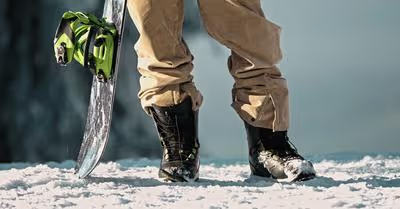Table of Contents
Do Snowboard Bindings Fit All Boots?
Snowboard bindings are designed to be compatible with all snowboards, but not all boots. They are specifically designed to fit the standard width of a snowboard, so if your boot is wider than that, it will not work with the binding.
The size of the binding may also be too small for you if you have large feet or wear tight socks during winter sports. This can cause discomfort and pain in your feet when you ride, making it difficult to enjoy your time on the slopes.
Snowboard bindings come in many different shapes and sizes. There are many to choose from when you are looking for a new pair of snowboard bindings.
Bindings are designed to fit a specific type of boot. The binding is made to match the boot in terms of the heel strap, toe strap, and ratchet system.
A snowboarder's boots should be compatible with their bindings. If not, they will not be able to properly engage and release from the bindings while riding on the snowboard.
The bindings are designed to be compatible with all types of boots, but the exact size and flex are important to get the best fit. We will discuss how to identify these two critical factors to find the fit you need.
Flex is important because it determines how much pressure you put on your boots when you turn or ride a jump. The size is important because if it is too big or too small, it can be uncomfortable and make riding difficult.
How To Know If Your Snowboard Boots Fit In The Bindings
If you are new to snowboarding, you might find it difficult to tell if your boots are fitting correctly. It can be tricky to know exactly how they should feel and the proper fit to ensure you can maximize your performance.
It is a common misconception that the toe cap of the boot should be resting on the front of the binding. The toe cap should be resting on the back of the binding. If it is not, then your boots are too big for your bindings and you will experience a lot of pain while riding.
Boots need to fit in your bindings or else they could cause injury to your feet and ankles while you ride. If you have any questions about how to know if your snowboard boots fit in your bindings, contact a professional at a local board shop for assistance.
It is important that you have a good fit in your snowboard boots and bindings because it will help with the stability and safety of your ride. It is also important to make sure that the right size of boot goes in the right size of binding.
Make sure your heel is touching the back of the binding when you put on your snowboard boot. If they are not, it means that there is space between them and this could be a problem for stability and safety during a ride.
You also need to make sure that the snowboard boots have a proper fit around your ankle and are not too tight or too loose. You do not want to have boots that squeeze your feet and cause constant discomfort.
If they are too tight, then it will cause pain and discomfort while riding on them as well as an improper fit in the bindings which can lead to injury or pain later on down the line.
Types Of Snowboard Boots
The primary purpose of snowboard boots is to provide a rigid, supportive structure for the foot and ankle during snowboarding. They are designed to fit snugly around the feet, usually with a zipper on the inside of the boot to make entry and exit easier.
Snowboard boots come in different shapes and sizes. There are three primary types of boots to keep in mind that all work well with every snowboard binding.
Freestyle Boots
Freestyle boots are typically the most beginner-friendly with a bigger flex and more give. These boots are designed to give riders an easier time when they first start snowboarding, but they can also be used by professional athletes as well.
The main difference between freestyle and other boots tend to have a larger flex and more give in them, which is great for beginners who want to learn how to ride without feeling like their feet are being locked into place.
They also tend to have more shock absorption when riding. This helps when going down steep hills or moving at faster speeds to stay balanced.
All-Mountain Boots
All-mountain snowboard boots are the most versatile and they are the best for riders who want to enjoy all types of terrain. These boots provide the most balance between comfort and performance.
They tend to have a medium flex which is great for riders who want to enjoy both powder and groomed runs. It has a medium flex and it can be used for a variety of purposes. The primary use of these boots is for casual riding.
They are designed to keep the rider comfortable and safe on the slopes. The boot is the only thing that connects you to your board, so it needs to be comfortable and durable.
Freeride Boots
Freeride snowboard boots are designed for the rider who wants to go fast. They have the stiffest flex of all three types of snowboard boots, meaning they provide maximum performance and speed.
They have a special construction that provides support in the ankle area, which is important for riders who want to maintain stability when they are going at higher speeds. They also give the most traction on the board.
This type of boot is great for those who want to maximize their speed and performance. They tend to be the most expensive snowboard boots and are made for the most experienced snowboarders.
What Boots Should You Use With Each Snowboard Binding?
Choosing the right boots for snowboarding is an important decision. Not only will they protect your feet from the cold, but they will also provide you with stability and support while you're riding.
The right boot can make all the difference when it comes to performance and comfort on the slopes. Below we have listed the three types of snowboard bindings along with the best snowboard boot type and flex to use with each.
Strap-In Bindings
Strap-in bindings are the most common type of snowboard binding. They are the most forgiving with snowboard boot size too. The strap-in bindings can be adjusted to fit almost any size of boots.
These bindings require a boot with a heel loop to be inserted into the binding. You should also opt for a more flexible snowboard boot with these bindings because of the pressure they will add to your heels for board control.
Speed-Entry Bindings
Speed-Entry snowboard bindings are designed to be fast and responsive. They are best suited for a stiffer snowboard boot that will provide the necessary support.
There are many great advantages of using Speed-Entry snowboard bindings. They are lightweight and have a very low profile. The only downside is that they can be difficult to release in some circumstances.
The stiffer your boot, the better it will work with speed-entry bindings. If you are looking for performance, we recommend a stiff boot with them.
Step-In Bindings
Step-in bindings are less common but they are very convenient. You should use a soft flex snowboard boot with this binding.
This is a binding that has a built-in heel cup, which means it doesn't have to be fastened separately. This is great because it means you can get on the board and go, which is convenient.
If you prioritize faster entry into your board, this is the ideal binding for you. It is quick to lock your boots into place and the sizing is much more versatile.
Recent Articles
















